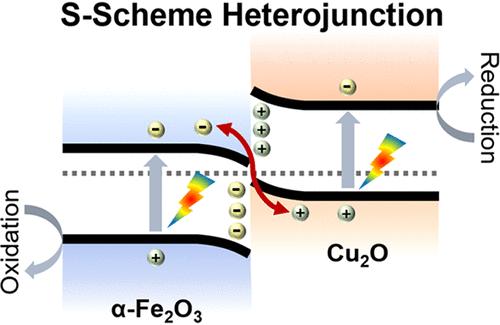Engineering Direct S-Scheme Heterojunctions with Ultrafast Interfacial Charge Transfer: A Case Study on 2-Dimensional α-Fe2O3/Cu2O Interfaces
IF 8.2
2区 材料科学
Q1 MATERIALS SCIENCE, MULTIDISCIPLINARY
引用次数: 0
Abstract
Longer wavelengths of light contain less energy but comprise more of the solar spectrum, making them important to incorporate into any process aiming for high efficiency. Here, we developed a novel redox-mediated synthetic mechanism to construct a heterojunction with strongly coupled interfaces. Specifically, an α-Fe2O3/Cu2O/CuO nanosheet composite was synthesized, forming an S-scheme α-Fe2O3/Cu2O electronic interface, a burgeoning class of materials designed to upconvert longer wavelengths of light and utilize solar energy more effectively. Through a series of experiments including X-ray photoelectron spectroscopy (XPS), ultraviolet–visible (UV–Vis) diffuse reflectance spectroscopy (UV–Vis-DRS), electrochemical impedance spectroscopy (EIS), and photocatalytic measurements, we were able to fully confirm the electronic structure of the α-Fe2O3/Cu2O interfacial heterojunction. These characterizations demonstrate the S-scheme flow of electrons, which is further supported by COMSOL numerical simulations. The successful formation of the S-scheme heterojunction is made possible through the direct Fe–O–Cu covalent bonding at the interface. These bonds provide ultrafast interfacial charge transfer pathways on picosecond time scales followed by long-lived charge-separated states, as quantified by our transient optical experiments. The proposed redox-mediated synthetic strategy provides a valuable guideline for constructing effective solid heterojunctions with strongly coupled interfaces, which are desirable for various applications in catalysis, energy storage, electronics, photovoltaics, and beyond.

具有超快界面电荷转移的工程直接s型异质结:二维α-Fe2O3/Cu2O界面的实例研究
波长较长的光包含较少的能量,但包含更多的太阳光谱,这使得它们在任何旨在提高效率的过程中都很重要。在这里,我们开发了一种新的氧化还原介导的合成机制来构建具有强耦合界面的异质结。具体来说,合成了α-Fe2O3/Cu2O/CuO纳米片复合材料,形成了S-scheme α-Fe2O3/Cu2O电子界面,这是一种新兴的材料,旨在上转换更长波长的光,更有效地利用太阳能。通过x射线光电子能谱(XPS)、紫外-可见(UV-Vis)漫反射光谱(UV-Vis - drs)、电化学阻抗谱(EIS)以及光催化测量等一系列实验,我们能够充分确认α-Fe2O3/Cu2O界面异质结的电子结构。这些特征证明了电子的s格式流动,并得到了COMSOL数值模拟的进一步支持。通过在界面上直接形成Fe-O-Cu共价键,成功形成了s型异质结。这些键在皮秒时间尺度上提供了超快的界面电荷转移途径,随后是长寿命的电荷分离状态,正如我们的瞬态光学实验所量化的那样。提出的氧化还原介导合成策略为构建具有强耦合界面的有效固体异质结提供了有价值的指导,这在催化,储能,电子,光伏等领域的各种应用都是理想的。
本文章由计算机程序翻译,如有差异,请以英文原文为准。
求助全文
约1分钟内获得全文
求助全文
来源期刊

ACS Applied Materials & Interfaces
工程技术-材料科学:综合
CiteScore
16.00
自引率
6.30%
发文量
4978
审稿时长
1.8 months
期刊介绍:
ACS Applied Materials & Interfaces is a leading interdisciplinary journal that brings together chemists, engineers, physicists, and biologists to explore the development and utilization of newly-discovered materials and interfacial processes for specific applications. Our journal has experienced remarkable growth since its establishment in 2009, both in terms of the number of articles published and the impact of the research showcased. We are proud to foster a truly global community, with the majority of published articles originating from outside the United States, reflecting the rapid growth of applied research worldwide.
 求助内容:
求助内容: 应助结果提醒方式:
应助结果提醒方式:


